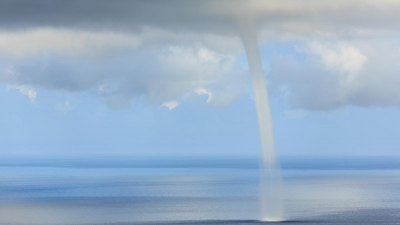What Causes Waterspouts to Appear Out of Clear Skies
Discover the surprising causes of waterspouts forming unexpectedly in clear skies.

Waterspouts are one of nature's most captivating phenomena, often appearing unexpectedly. These tornado-like structures form over water and can develop in seemingly clear weather conditions. Understanding the science behind their formation not only fascinates meteorologists but also alerts sailors and coastal residents to the potential dangers they pose. In this article, we will explore what causes waterspouts to appear out of clear skies.
Waterspouts are essentially tornadoes that form over a body of water. They occur when a intense localized convective system creates a column of rotating air. While they can develop from thunderstorms, they can also form in calm conditions due to specific atmospheric phenomena. A key factor in waterspout formation is the temperature contrast between the air above the water and the surface of the sea, as well as humidity levels.
Temperature Gradients
The first condition necessary for a waterspout to develop involves a steep temperature gradient. When the water temperature is significantly warmer than the air above, it creates instability in the atmosphere. Warm air rises, and as it ascends, it cools and condenses, forming cumulus clouds. Even if the sky appears clear, localized warm air rising can create favorable conditions for a waterspout to develop in the absence of large storm clouds.
Humidity Levels
Humid air is essential for the formation of waterspouts. When warm, moist air rises, the moisture content begins to condense into clouds. The condensation releases latent heat, further enhancing the upward motion of air. When this process occurs over a large body of water, the combination of warm surface temperatures and high humidity creates an environment ripe for waterspout development. Even a small disturbance can trigger this process and lead to the emergence of a waterspout.
Wind Shear
Wind shear, or the variation of wind speed and direction with height, is another critical factor. Waterspouts typically require a certain degree of wind shear to form. A light wind at the surface facilitates the rise of warm air, while stronger winds aloft can help tilt the rotating column of rising air. This can happen in clear weather, where surface winds can create localized areas of uplift without the presence of overt storm systems.
Localized Convection
Localized convection is vital in the creation of waterspouts. Even in the absence of significant storms, localized heating can create thermals - columns of warm rising air. These can occur due to heat absorption from the sun by the water surface, especially on hot days. As these thermals rise, they may begin to rotate slightly, creating conditions ripe for a waterspout, as the rotation is often amplified by the prevailing winds.
Sea Surface Temperature
Another essential factor in waterspout formation is the sea surface temperature. Warmer water not only promotes higher humidity through evaporation but also encourages the development of thunderstorms, even isolated ones that lack significant cloud cover. Water temperatures that exceed 70°F are particularly conducive to waterspout formation due to the increased evaporation rates that come with such warm conditions.
Interaction with Other Weather Systems
Sometimes, waterspouts can form as a result of interactions with nearby weather systems, including cold fronts or upper-level disturbances. Even if the immediate area appears clear, the upward motion associated with these systems can trigger convection based on localized lifting. The result could be a waterspout forming several miles away from the storm itself.
Seabreeze Fronts
Seabreeze fronts can also lead to clear-sky waterspout formation. These occur when cooler air from the land interacts with warmer, moist air coming off the ocean. As this cool air pushes inland from the beach during the day, it interacts with the warm air above, which can condense and trigger isolated, convective storms, resulting in waterspouts forming in otherwise clear conditions.
Microclimates
Microclimates, or small areas with distinctive climatic conditions, can contribute significantly to waterspout formation. These can arise from varying terrain, differing land use, and water conditions affecting local atmospheric dynamics. For example, an isolated patch of warm water surrounded by cooler currents can create localized air lifts that contribute to waterspout development.
Observational Studies
Research into waterspouts is ongoing with scientists using both observational studies and advanced computer models to better understand their formation. Weather satellites provide data on sea surface temperatures, humidity levels, and wind patterns, aiding in forecasting potential waterspout events. The collaboration between meteorologists and oceanographers is crucial in developing predictive models that account for the variances induced by local weather patterns.
Challenges of Prediction
Predicting the exact formation of waterspouts remains a challenge due to their transient nature. Unlike tornadoes generated from robust thunderstorms, waterspouts often develop quickly and dissipate just as fast, giving little time for alerts. However, increasing awareness about conditions leading to their formation can help mitigate risks for mariners and those residing along coastlines.
Warning Systems
Currently, many weather agencies issue warnings when conditions are favorable for waterspouts. Boaters and coastal inhabitants are encouraged to stay informed through official weather channels, especially in warm, humid conditions where sudden changes in weather can lead to the rapid emergence of a waterspout.
Safety Precautions
For those who encounter a waterspout while on the water, it’s crucial to know safety precautions. The first step is to immediately navigate away from the waterspout’s path if spotted. Depending on the size and the force of the waterspout, it may bring hazardous winds and rough seas, so seeking harbor or safe distance is advisable. Mariners should avoid attempting to outpace the waterspout, as they can change direction swiftly.
In summary, waterspouts are a fascinating example of nature's power that can appear unexpectedly even in clear skies. Their formation relies on specific atmospheric conditions such as temperature gradients, humidity levels, wind shear, and localized convection. Understanding these phenomena not only deepens our appreciation for meteorology but also enhances safety for those who work and play along our waterways. As research continues, improving our predictive models and warning systems will be crucial in protecting lives from these dynamic weather events.











